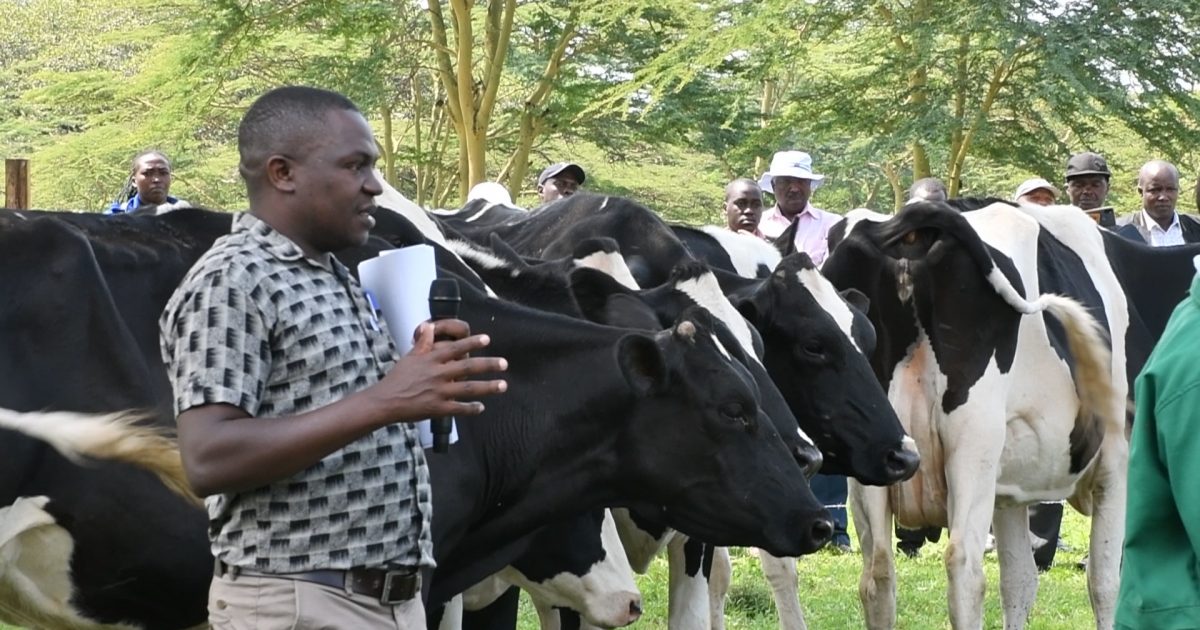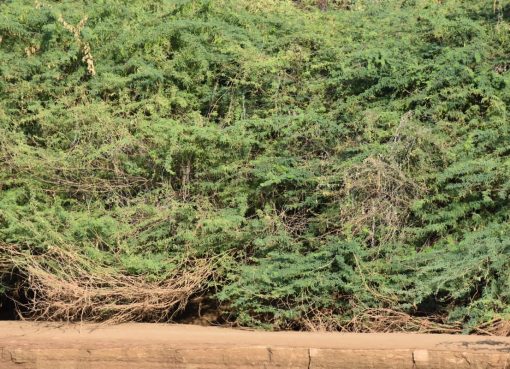Over 100 livestock breeders from Narok County have benefitted from a superior breed of dairy cows developed by the Kenya Agriculture and Livestock Research Organization (KALRO), which will significantly boost their milk output.
The breeders from Maasai community in Trans Mara South have been incorporated in a community-based genetic improvement and multiplication programme funded by the government through National Research Fund (NRF) for a three-year program to restock the superior breed of Sahiwal.
According to the breeders’ spokesperson Mr. Wilson Kibeno the KALRO-led programme has assisted the community to produce 309 superior Sahiwal AI calves which have been distributed among members of community-based breeding scheme in Trans Mara.
Speaking at Rift Valley Institute of Science and Technology during a farmers’ field day organized by the Kenya Livestock Breeders Association, Mr. Kibeno explained that through the programme 65 farmers and extension personnel have also been trained on good Sahiwal cattle management practices. The group showcased their improved animals during the field day.
Currently, the spokesman notes that accessing the right Sahiwal heifers and bulls at affordable prices has been the worst nightmare for many farmers, especially Maasai pastoralists across the country who heavily rely on Sahiwal genetic resources for their livelihood.
Compared with small indigenous zebu which is the dominant variety in Narok County, Mr. Kibeno points out that the new breed produces five to 15 litres more milk per day.
The spokesman explains, “The body weight of the cross-breed perks is up from 250kg live weight to 350kg and is highly tolerant to pests, diseases and adverse climatic conditions compared to exotic breeds that are vulnerable to diseases.”
The age at first service is condensed from three years for local zebu to two years for the cross breed.
The new cross breed requirement for feed is less compared to Holstein Friesian that will demand more feed per litre of milk produced.
The breeders and the pastoral community in Trans Mara South, Mr. Kibeno adds, are further being enlightened about the Kenya Livestock Insurance Programme (KLIP), a National Government’s initiative in collaboration with county governments whose objective is to protect livestock against the risks associated with drought effects, through satellite-based index insurance.
Under the programme, which started in 2016, the cover is also an asset protection to provide payouts to pastoralists for purchase of fodder to keep their livestock alive. In the event of a trigger, payouts shall be transferred to the bank accounts or mobile payment systems of the registered beneficiaries.
“The overall objective of Kenya Livestock Insurance Programme is to minimize risks emanating from drought-related disasters and build resilience of pastoralists for enhanced and sustainable food security,” says Mr. Kibeno.
KALRO’s Director General Dr Eliud Kireger indicated that the improved cross breed between the indigenous Sahiwal and the exotic Friesian was resistant to most pests and diseases and had the potential of yielding 30 litres of milk per day.
As part of its efforts to increase milk production in the country, Dr Kireger said KALRO through its Dairy Institute in Naivasha had begun training farmers on breeding, disease control and animal health, feed formulation, value addition and marketing in the dairy subsector.
The new breed can produce an average of 30 litres of milk per day without intensive feeding.
Apart from high milk production, other notable performance indexes that are exciting the farmers and researchers include average lactation yield of 3,000 litres per lactation.
The age at first calving is at 33 months and has a calving interval of 420 days with a weaning age of three months. Heifers from the cross breed are served at the weight of 340 kg which is between 22-24 months.
He adds, “The improved dairy cow breeds fit within the nomadic pastoral system of production that is dominant in the regions. KALRO is also encouraging pastoralists to keep fewer animals, but with higher milk or meat production potential.”
According to the Director General, the breed has few calving problems and is recommended for areas like Nakuru, Baringo, Koibatek, Kajiado, West Pokot, Machakos, Taita Taveta, parts of Nyeri and Elgeyo Marakwet.
Dr Kireger notes that since they kicked off the programme, by training the villagers who were in 12 clusters, they have over 170 bulls locally with farmer groups in the Lolgorian Division in Trans Mara where the demand for the breed was very high. The superior genetic material, he says, is now circulating in the area.
Kenya Livestock Breeders Association Chief Executive Officer Mr. Leonard Mukhebi reveals that 1,234 Sahiwal cows and bulls have been registered with Kenya Stud Book as either foundation or pure-bred classes since the start of the three-year programme.
“The registered animals have been issued with certificates by the Kenya Livestock Breeders Association and their market price has increased threefold,” Mr. Mukhebi says.
To achieve effective population and genetic diversity for Sahiwal cattle, he notes that the programme is mobilizing the entire community including women for the cause of genetic improvement and multiplication of Sahiwal genetics.
“It is our sincere prayer that KALRO will replicate the programme in other parts of the country to boost Sahiwal cattle production so that at the end of it there will also be an increased Sahiwal cattle resilience, translating into higher production with surplus for sale and farmers enabled to secure their food and nutrition security,” states Mr. Mukhebi.
Sahiwal cattle in Kenya are descendants of some 60 bulls and 12 cows imported between 1939 and 1963 and KALRO is one of the leading world’s custodian of Sahiwal, a dual-purpose (meat and milk) breed which is highly tolerant to semi-arid and arid conditions.
The CEO indicates that despite the importance of Sahiwal cattle, its production is affected by several challenges including acute unavailability of quality climate resilient breeding stock, inbreeding which leads to loss of genetic diversity and low productivity.
Elizabeth Njeri, a large-scale dairy farmer from Njoro Sub-County singles out the high cost of animal feed as one of the biggest challenges the dairy sub-sector has been grappling with, which she indicated makes the venture non profitable.
Ms. Njeri points out that besides inhibitive costs of feed, thousands of dairy farmers in Nakuru County are counting losses running into millions of shillings due persistent adulteration of animal feeds in the country.
Most dairy farmers in the country, she adds, practice free range dairy farming, relying on rains for pasture.
The recent drought affected milk production, cutting yields by nearly half. Ms. Njeri says by reducing costs, farmers will significantly be able to access quality animal feeds.
“Most farmers and their animals are recovering from the drought and most of them had resorted to other waste products such as rice germ due to shortage of maize. One cow can consume on average six kilogrammes per milking in a day and the cost goes up, depending on the number of herd.”
The recent drought affected milk production, cutting yields by nearly half. Ms. Njeri says by reducing costs, farmers will significantly be able to access quality animal feeds.
“Most farmers and their animals are recovering from the drought and most of them had resorted to other waste products such as rice germ due to shortage of maize. One cow can consume on average six kilogrammes per milking in a day and the cost goes up, depending on the number of herd.”
She appeals to the government to make use of Agricultural Development Corporation’s (ADC) land to grow hay which can be sold to farmers at a subsidized rate.
Ms. Christine Kiboi, a farmer from Limuru, says she might be forced to reduce her herd should the cost of feed remain unchanged.
“The cost of feed is the main challenge to most farmers. Although we are happy with milk prices, I might have to reduce the number of cows from eight to four should things remain the same,” states the farmer.
Ms. Kiboi notes that farmers were forced to sometimes use farm waste due to the shortage of maize.
“We normally grind maize grains due to shortage of dairy meal but now we use wheat bran or maize stalks,” she adds.
The lucrative dairy sub-sector contributes 3.5 per cent of the total Gross Domestic Product (GDP).
The current milk output is estimated at 5.2 billion litres per annum out of which 60 per cent is from grade dairy cattle and their crosses while the remaining 40 per cent comes from zebu, camel and goats.
The national dairy herd is estimated to be 3.3 million head, majority of which are grade cattle. One million smallholder farmers account for about 2.5million dairy cows producing over 80 per cent of total national milk output.
The informal milk sector accounts for more than 70 per cent of the 40,000 jobs in dairy marketing and supports over 350,000 others in formal employment.
By Jane Ngugi and Dennis Rasto




